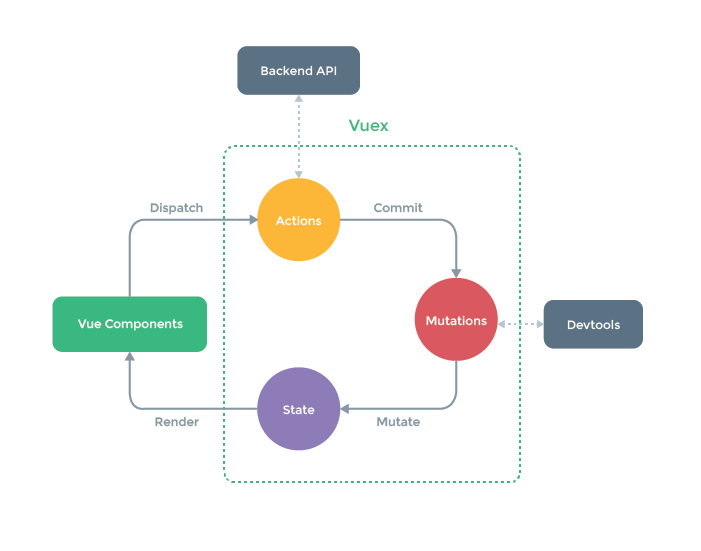Appearance

什么是状态管理
在开发中,我们会的应用程序需要处理各种各样的数据,这些
数据需要保存在我们应用程序中的某一个位置,对于这些数据 的管理我们就称之为是 状态管理。
vuex之前的开发 是如何管理状态
vue开发中使用组件化的方式
在组件中我们定义 data 或者 在 setup 中返回使用的数据 我们成为state
在template中我们可以使用这些数据, 模块最终会被渲染成dom 我们称为view
当我们在 组件中需要处理一些事件的行为 需要修改state 然后重新渲染 dom 这些行为我们成为 action

复杂的状态管理
在javascript 越来越复杂的情况下 我们需要管理的状态越来越多 或者多个组件共享视图 依赖同一状态,随着复杂的管理状态下 单纯通过组件props 和 provide 的方式来共享状态
Vuex的状态管理
管理不断变化的state是非常困难的
组件之间状态相互依赖 一个状态会引起 其他状态的变化 当应用程序复杂时, state在什么时候 因为什么发生变化 数据将会变得难追踪
因此我们需要将组件的内部状态抽离出来, 以一个全局单例的方式来管理
安装
我们要使用vuex 所以我们要先安装vuex
js
pnpm install vuex
创建store
每一个vuex应用的核心就是 store store本质上就是一个容器
vuex 和 全局对象有什么区别
第一, vuex状态是响应式的 只要store 中的 状态发生变化 那么相应的组件也被会更新
第二, 我们不能直接修改store 中的 state 状态 修改store 中的状态 唯一途径就是commit 提交, 方便我们跟踪每一个状态的变化
Vue devtool
vue devtool 我们需要安装 最新 支持 vue3版本 目前是 6.0.0beta21
如果可以科学上网, 我们直接在谷歌商店安装 简单 方便
因为我们不能科学上网 所以我们需要手动安装
- vue-devtool安装
执行 pnpm install
执行 pnpm build
打包完成之后 直接 扔到谷歌扩展程序中
Vue2中的基本使用
js
// src 目录新建store && mk index.js
import Vue from 'vue'
import Vuex from 'vuex'
Vue.use(Vuex)
// 新建store
const store - new Vuex.store({
state() {
return {
name: 'erkelost',
girl: 'adny'
}
},
getters: {
fullName(state, getters) {
return `${state.name}-${state.girl}`
}
},
mutations: {
setGirlName(state, newName) {
state.girl = newName
}
},
actions: {
girlNameAction({ commit }) {
setTimeout(() => {
commit('setGirlName', 'foo')
}, 1000)
}
},
modules: {
}
export default store
})
state 的基本使用
js
// 我们可以直接在tempalte中使用
<p>{{ $store.state.name }}</p> // template 编译 具有代理模式 直接使用 $store 不需要使用this.
// 我们可以使用计算属性 返回 计算属性
computed: {
name() {
return this.$store.state.name
}
}
使用mapState 辅助函数
js
import { mapState } from 'vuex'
computed: {
...mapState(['name', 'girl']) // 数组类型
...mapState({
newName: state => state.name,
newGirl: state => state.girl
})
}
getters的基本使用
某些属性我们可能需要经过变化之后来使用 这个时候我们可以使用getters
js
<p>{{ $store.getters.totalPrice }}</p>
state() {
return {
books: [
name: 'vuejs', price: 200, count: 5,
name: 'flutter', price: 50, count: 2,
name: 'reactjs', price: 150, count: 3,
]
}
},
getters: {
totalPrice(state) {
let totalPrice = 0
for (const book of state.books) {
totalPrice += book.count * book.price
}
return totalPrice
}
}
getters可以接收第二个参数
js
getters: {
totalPrice(state, getters) {
let totalPrice = 0
for (const book of state.books) {
totalPrice += book.count * book.price
}
return totalPrice * getters.discount // 我们可以调用其他的getters
},
discount(state) {
return 0.5
}
}
getters的返回函数
getters 中的函数本身 可以返回一个函数 那么在使用的地方相当于可以调用这个函数
js
getters: {
totalPrice(state) {
return price => {
let totalPrice = 0
for (const book of state.books) {
if (book.price < price) continue
totalPrice += book.price * book.count
}
return totalPrice
}
}
}
mapGetters 的辅助函数
我们依然可以使用 mapGetters的辅助函数
js
computed: {
...mapGetters(['totalPrice', 'discount']) // 数组形式
...mapGetters({
finalPrice: 'totalPrice',
finalDiscount: 'discount'
})
}
mutation基本使用
更改 Vuex 的 store 中的状态的唯一方法是提交 mutation:
js
state() {
return {
counter: 5
}
},
mutations: {
// 不携带参数的 mutations
increment(state) {
state.counter ++
},
decrement(state) {
state.counter --
},
// 携带参数的 mutations
addNumber(state, number) {
state.counter += number
},
// payload 为对象类型
addNumber(state, payload) {
state.counter += payload.count
}
}
// 在组件中 提交方式
methods: {
click() {
// 正常提交风格
this.$store.commit('addNumber', 555)
this.$store.commit('addNumber', { counte: 555 })
// 对象风格提交方式
this.$store.commit({
type: 'addNumber',
count: 555
})
}
}
mutations常量类型
有时候 我们为了防止 mutations命名写错 但是 代码不会报错 我们会选择 定义成常量
首先我们新建mutations-type.js
js
// 定义常量
export const ADD_NUMBER = 'ADD_NUMBER'
// 定义mutation
[ADD_NUMBER](state, payload) {
state.counter += payload.count
}
// 提交mutations
this.$store.commit({
type: ADD_NUMBER,
count: 100
})
mapMutations辅助函数
我们也可以借助于辅助函数 帮助我们快速映射到相对应的方法中
js
methods: {
...mapMutations({
addNumber: ADD_NUMBER
})
...mapMutations(['increment', 'decrement'])
}
mutations重要原则
- 一条重要的原则就是要记住 mutation 必须是同步函数
- 这是因为devtool工具会记录mutation的日记
- 每一条mutation被记录,devtools都需要捕捉到前一状态和后一状态的快照
- 但是在mutation中执行异步操作,就无法追踪到数据的变化
- 所以Vuex的重要原则中要求 mutation必须是同步函数
actions的基本使用
action类似于mutation 不同在于
- action提交的是mutation 而不是直接变更状态
- action可以包含任意异步操作
js
mutations: {
increment(state) {
state.counter++
}
},
actions: {
incrementAction(context) {
context.commit('increment')
}
}
重要参数context
context是一个和store实例均有相同方法和属性的context对象;所以我们可以从其中获取到commit方法来提交一个mutation,或者通过 context.state 和 context.getters 来 获取 state 和 getters;
actions的分发操作
那么我们如果使用action呢 进行action的分发
js
methods: {
// 分发使用的是store上的dispatch
add() {
this.$store.dispatch('increment')
}
// 当然我们也可以携带参数
add() {
this.$store.dispatch('increment', { count: 100 })
}
// 也可以使用对象的形式进行分发
add() {
this.$store.dispatch({
type: 'increment',
count: 1000
})
}
}
actions的辅助函数
actions 也有对象和 数组的辅助函数
js
import { mapActions } from 'vuex'
methods: {
...mapActions(['increment', 'decrement'])
...mapActions({
add: 'increment',
sub: 'decrement'
})
}
actions的异步操作
Action 通常是异步的,那么如何知道 action 什么时候结束呢?
我们可以通过让action返回Promise,在Promise的then中来处理完成后的操作;
js
actions: {
increment({ commit }) {
return new Promise(resolve => {
setTimeout(() => {
commit('increment')
resolve('数据加载完成')
}, 1000)
})
}
}
module的基本使用
由于使用单一状态树,应用的所有状态会集中到一个比较大的对象,当应用变得非常复杂时,store 对象就有可能变得相当臃肿;
为了解决以上问题,Vuex 允许我们将 store 分割成模块(module);
每个模块拥有自己的 state、mutation、action、getter、甚至是嵌套子模块;
js
// 新建 module 文件夹
// new add mk dir mudulea
const moduleA = {
state: () => {
},
mutations: {},
actions: {},
getters: {}
}
// new add mk dir muduleb
const moduleB = {
state: () => {
},
mutations: {},
actions: {},
getters: {}
}
// 在index.js 中
const store = new Vuex.store({
state() {
return {
}
},
modules: {
a: moduleA,
b: moduleB
}
})
module的局部状态
对于模块内部的mutations的getter 接收的第一个参数是模块的局部状态对象
js
mutations: {
changeName(state, data) {
state.name = data
}
},
getters: {
info(state, getters, rootState) {
return `${state.naame}-${rootState.counter}`
}
},
actions: {
changeNameAction({ state, commit, rootState }) {
commit('changeName', 'erkelost')
}
}
module的命名空间
DANGER
默认情况下,模块内部的action和mutation仍然是注册在全局的命名空间中的, 这样使得多个模块能够对同一个 action 或 mutation 作出响应; Getter 同样也默认注册在全局命名空间 如果我们希望模块具有更高的封装度和复用性,可以添加 namespaced: true 的方式使其成为带命名空间的模块 当模块被注册后,它的所有 getter、action 及 mutation 都会自动根据模块注册的路径调整命名;
js
// MouduleA.js ->
export default {
namespaced: true,
state() {
return {}
}
}
如何访问
js
// user模块
export default {
namespaced: true,
// $store.state.user.name
state() {
return {
name: 'erkelost'
}
},
// 访问 $store.commit('user/changeName')
mutations: {
changeName(state) {
state.name = 'adny'
}
},
// $store.getters['user/info']
getters: {
info (state, getters, rootState, rootGetters) {
return `${state.name}-${rootState.name}`
}
},
actions: {
changeNameAction({ commit, dispatch, state, rootState, getters, rootGetters }) {
// 当前 模块
commit('changeName', "adny")
// 根 root
commit('changeRootName', null, { root: true })
dispatch('chaangeRootName', null, { root: true })
}
}
}
module修改或派发根组件
如果我们希望在 模块中 修改 root 中的 状态 那么有如下的方式
js
actions: {
changeNameAction({ commit, dispatch, state, rootState, getters, rootGetters }) {
// 当前 模块
commit('changeName', "adny")
// 根 root
commit('changeRootName', null, { root: true })
dispatch('chaangeRootName', null, { root: true })
}
}
module的辅助函数
module的辅助函数一共有三种使用方法
js
import { mapActions, mapState, mapMutations, mapGetters, createNameSpacedHelpers } from 'vuex'
// 第三种写法 这种写法 就在当前模块中我们使用的 就是当前模块的 根root 方法
const { mapState, mapMutations, mapActions, mapGetters } = createNameSpacedHelpers('home')
export default {
computed: {
// 第一种 对象写法
...mapState({
counter: state => state.user.counter
})
...mapGetters({
dobuleHomeCounter: "user/doubleHomeCounter"
})
// 写法二 数组
...mapState('user', ['counter'])
...mapGetters('user', ['doubleHomeCounter'])
},
methods: {
// 写法一
...mapMutations({
increment: 'home/increment'
})
...mapActions({
incrementActions: 'home/incrementActions'
})
// 写法二
...mapMutations('home', ['increment'])
...mapActions('home', ['incrementActions'])
}
}
